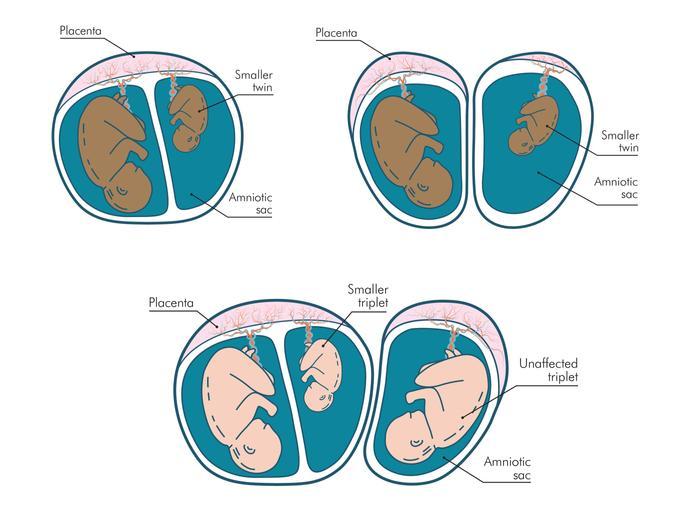Just like singletons, sometimes twins and multiples are smaller than expected for their gestational age. This is called growth restriction and can be detected by regular ultrasound measurement of the babies’ sizes. This can happen because they are meant to be small (especially if you are on the shorter side yourself!) or might be because of a problem with the placenta or their health. Where a small baby is identified, a specialist will assess all the babies to try and find out the reason why.
The diagrams below illustrate selective fetal growth restriction in a twin and triplet pregnancy.

Selective fetal growth restriction
Most twin, triplet or more babies will be slightly different in size, but sometimes one baby is significantly smaller than the other/s. This is called ‘selective’ growth restriction (sFGR). It can happen in multiples who have their own placentas (like dichorionic twins) and also in multiples that share a placenta (monochorionic) but the causes and treatment are different in each case. Selective fetal growth restriction occurs in 10-20 percent of twin, triplet or more pregnancies.
Is sFGR the same as TTTS?
Sometimes babies affected by TTTS are also affected by sFGR, but these are separate conditions. While TTTS is mainly related to the unequal volumes of blood shared by babies across their placenta, growth restriction is related to the size, function and each twin’s share of the placenta.
What are the effects of sFGR on the babies?
sFGR can be serious for one or both babies and a specialist assessment is recommended. The blood flow to the babies is associated with the risk of complications – in most cases the blood flow (Doppler) measurements are normal, and in this case the babies are likely to do well with careful monitoring for the rest of the pregnancy. If the blood flow measurements are not reassuring, a specialist will explain treatment options to you.
Login now to download our Complications Guide which is designed to help you to understand some of the conditions associated with twin, triplet and higher-order pregnancies. Not registered yet? Create an account today to unlock these resources.
-strap.svg)